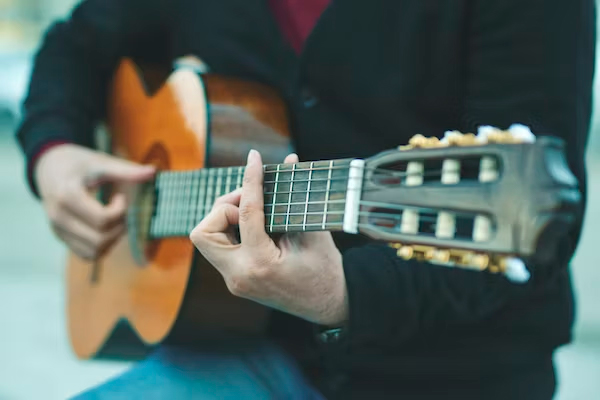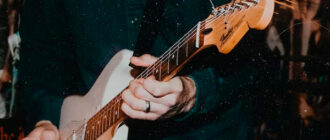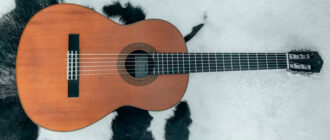
How to Use a Capo to change Keys : Unlock the secrets of effortlessly playing your favorite songs and changing keys with ease! Whether you’re a beginner or an experienced guitarist, mastering the art of using a capo can transform your playing. In this guitar lesson, discover the 5 steps to effectively use a capo for seamless key changes, unlocking a world of musical possibilities.
Table of Contents
What Does A Capo Do on Guitar?
Before we dive into how to use a capo, let’s first understand what it does and where you put the capo. A capo is essentially a clamp that you place on the fretboard of your guitar. It works by shortening the length of the strings, raising the pitch of each string by a semitone for every fret that you move the capo up.
This means that if you place a capo on the 2nd fret and play a C chord, it will sound like a D chord and become easier to play and change the key of a song while you use capos. The original key (i.e., Em) will be changed in progression as if you put your index finger on the second fret. It will help if you want to sing and play higher chords. Try playing with the capo on the first fret and see if it is comfortable.
Capo Basics: The Movable Guitar Nut
Think of the capo as a movable guitar nut. Just like the nut, which is located at the top of the neck near the headstock, the capo changes the starting point of the strings. Instead of starting at the nut, they now start at the capo. This allows you to play the same chord shapes as before, but now in a different key. Play chords without learning new elaborate ones which would have to be learnt by the guitar player when playing songs on the guitar without a capo.
How to Use a Capo to change Keys?
Using a capo is easy! Simply place it on the desired fret, for example a third fret, making sure that it’s tight enough to hold down all the strings. You can then play the same chord shapes as before, but now in a higher key. For example, if you place the capo on the 2nd fret and play a G chord, it will sound like an A chord. If you place the capo on the 3rd fret and play a C chord, it will sound like a D chord.
Use a capo to transpose to any tone. Many guitarists use it, for example to play a song in the key of E or Bm. If a song is in the key that is uncomfortable to play, move a capo around to get the chords in the key of G major (if that is the key of the song).
How Do You Use a Capo for Beginners?

Image by Adhy Setya from Unplash
If you’re new to guitar, using a capo might for the right chords to play seem daunting at first. But don’t worry, it’s actually quite simple depending on the chords you play! Here’s a step-by-step guide to playing a song with capo:
1. Choose the fret where you want to place the capo. If you want to play in the key of G or a C major, for example, you can place the capo on the 3rd fret. You have to know a bit of music theory to understand the chord progression.
2. Place the capo on the fret, making sure that it’s tight enough to hold down all the strings. This is one of the main reasons why capo might sound off. It is definitely a thing to remember.
3. Play the same chord shapes as before, but now in a higher key. For example, if you play a G chord with the capo on the 3rd fret, it will sound like a Bb chord. Beginner guitarists should take time to figure out how different chords sound and transpose everything to learn to differentiate by sound.
What Key is Capo 3rd Fret?
If you place the capo on the 3rd fret, you will be playing in the key of G# or Ab. This means that if you play a C chord with the capo on the 3rd fret, it will sound like an Eb chord.
How Do You Transpose Keys with A Capo?
Transposing keys with a capo is easy! Let’s say you have a song that is in the key of C, but you want to play it in the key of G. Simply place the capo on the 7th fret and play the same chord shapes as before. This will transpose the song up by 5 semitones, putting it in the key of G.
How Does A Capo Change A Note?
As we mentioned earlier, a capo raises the pitch of each string by a semitone for every fret that you move it up. This means that if you place the capo on the 1st fret and play an E chord, it will sound like an F chord. If you place the capo on the 2nd fret and play a D chord, it will sound like an E chord.
What Key is 1st Capo?

Image by Becca Tapert from Unplash
If you place the capo on the 1st fret, you will be playing in the key of F. This means that if you play a C chord with the capo on the 1st fret, it will sound like a Db chord.
Tips
– When using a capo, it’s important to remember that the low E string is now the note that the capo is placed on. This means that if you place the capo on the 3rd fret, the low E string is now a G note.
– If you’re having trouble playing barre chords, using a capo can make it a lot easier. Simply place the capo on a higher fret and play the same chord shapes as before.
– If you’re not sure what key a song is in, you can use a capo chart to help you figure it out. Simply place the capo on different frets and play the chords until you find the right key.
Warnings
– Placing a capo too close to the nut can cause tuning issues.
– Using a capo too often can cause the strings to wear out more quickly.
– If you’re playing with other musicians, make sure they know that you’re using a capo so that they can adjust accordingly.
In conclusion, a capo is a great tool for guitarists of all levels. Whether you’re a beginner who wants to play in different keys or an experienced guitarist who wants to try new chord progressions, a capo allows you to play any song in any key. Take some time to learn how to use a capo, and you’ll be one step closer to playing your favorite songs with ease. Who knows, you might even be able to play some Beatles songs with a capo on!






